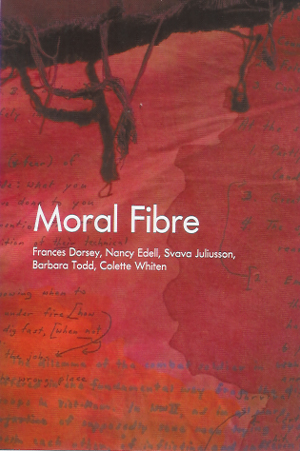 Home Exhibitions MSVU Collection Publications Posters Working Title Resources
Home Exhibitions MSVU Collection Publications Posters Working Title Resources
|
Home » Publications » Catalogue Excerpts » Moral Fibre
Moral Fibre   Purchase the catalogue Purchase the catalogueGo to the exhibition’s webpage... Essay By Ingrid Jenkner As a coeducational university that emphasizes the education of women, Mount Saint Vincent makes a point of acquiring works by women artists for its permanent collection of visual art. The current holdings include significant examples of contemporary textile-based art, some of which are on view in Moral Fibre. The event that inspired this exhibition was the gift to the University, in 2005, of There there by Colette Whiten. There there and Nancy Edell’s Operating were first exhibited in Halifax at the Art Gallery of Nova Scotia in the touring exhibition, Survivors in Search of a Voice (1995), which concerned women’s experiences with breast cancer. The subject matter of these works, “bodies in trouble,” extends throughout Moral Fibre, whether in reference to the ravages of disease or to those of war. Writing about Barbara Todd’s Security Blankets, Bruce Grenville proposes technophilia as the link between medical and military thinking: “When death comes, it is understood as a failure of technology, an inexplicable gap in the logic of its defense. In a seemingly impossible turn of events the language of medicine and the language of the military coincide around death. . .the failure of an artificial heart has the same immediate and totalizing effect as the failure of a radar defense system.” Because they are soft and associated with feminine and folk practices, the textile-based works in Moral Fibre prompt a consideration of technology which counterposes differently gendered and capitalized spheres of production. Needlework techniques connected with bedding, decoration and clothing are deliberately appropriated into works of art that take as their subject matter the public operations of military, “agribusiness” and medical organizations. Women’s traditional concern with vulnerable bodies reaches out, beyond the family, to implicate the ideologies and institutions that place life in jeopardy. In this sense of forwarding a social cause, the politically engaged textiles of Moral Fibre hearken back to their forerunners, the embroidered banners of the Woman’s Suffrage and Temperance movements.
The geometry of the quilt offers further opportunities for radical recomposition. In Barbara Todd’s appliqué coverlet, impeccable stitching and an orderly grid match the chilling ideology we might attribute to the “suits” who deal in the weaponry illustrated. By way of contrast, Frances Dorsey’s frayed, irregularly pieced patchwork, tacked up like a tarpaulin, looks war-torn even before one notices the soldiers, screaming children and crosses collaged into its imagery. Both works express pacifist ideas, yet even in their approaches to figuration (appliquéed empty suit versus cut-away silhouette) they demonstrate the myriad of ways in which cloth-based art can engage the mind through the senses. |